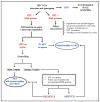Human Papillomavirus and Male Infertility: What Do We Know?
- PMID: 38139389
- PMCID: PMC10744208
- DOI: 10.3390/ijms242417562
Human Papillomavirus and Male Infertility: What Do We Know?
Abstract
In recent years, increasing attention has been paid to understanding the causes of infertility, which is being recognized as a growing health problem affecting large numbers of couples worldwide. Male infertility is a contributing factor in approximately 30-40% of cases, and one of its etiological causes is sexually transmitted infections (STIs). Among sexually transmitted pathogens, human papillomavirus (HPV) can contribute in various ways to the failure of spontaneous and assisted reproduction, acting in the different phases of conception, especially in the early ones. In particular, HPV infection can affect sperm DNA integrity, sperm motility, count, viability, and morphology and can induce the production of anti-sperm antibodies (ASAs). In this narrative review, we aimed to provide an overview of existing research on the potential adverse effects of HPV infection on male reproductive health. Furthermore, we analyzed how limiting the spread of the infection, particularly with gender-neutral vaccination, could be a possible therapeutic tool to counteract male and female fertility problems.
Keywords: ART; HPV; HPV infection; infertility; male infertility; sperm parameters; vaccination.
Conflict of interest statement
The authors declare no conflict of interest.
Figures


References
Publication types
MeSH terms
LinkOut - more resources
Full Text Sources
Medical

